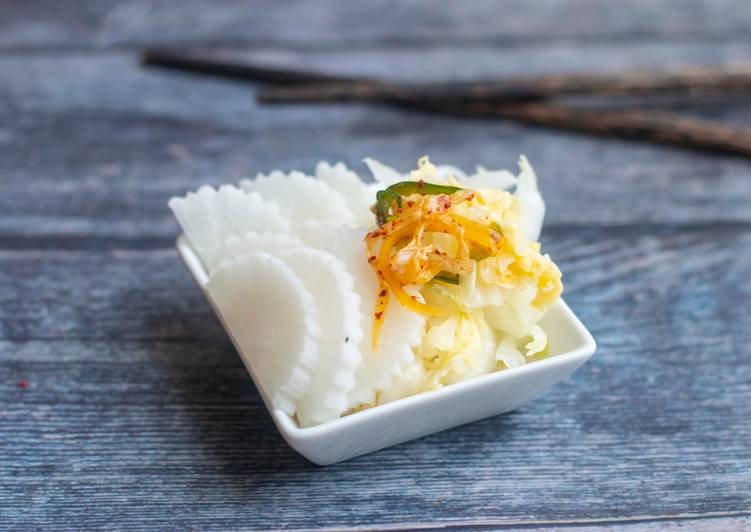This blog post was created prior to the Coronavirus outbreak and recent CDC social distancing recommendations. As many of us are spending more time at home, I hope this recipe inspires you to try something new and brings some joy. Stay safe!
It is quick and easy to prepare and also brings healthy fiber into your kitchen - our Vegetable Pickles or tsukemono. Since you cook the peppers in the oven, it becomes particularly aromatic and goes perfectly with gnocchi, hard cheese and balsamic cream. If there is anything left over, you can also use the Vegetable Pickles or tsukemono as a great lunch side dish the next day. Good Appetite! Fast, faster, express! With our express recipes you can conjure up a balanced and, above all, delicious dish on the table in no time!
If you are looking for an easy yummy snack try this Vegetable Pickles or tsukemono recipe. This Vegetable Pickles or tsukemono make for a yummy summer dinner that you can make it easy. The Vegetable Pickles or tsukemono recipe today I am going to share will surely make you relish the taste of home. Let’s explore the Vegetable Pickles or tsukemono recipe.
Vegetable Pickles or tsukemono. Japanese Pickles or Tsukemono (漬物) are a delicious way to preserve vegetables. Serve them along with a bowl of rice and miso soup for a traditional Japanese breakfast. Tsukemono literally translates to "pickled thing," and it's the Japanese umbrella term for pickles.
 Japanese pickles (�Е�, tsukemono) are an important part of the Japanese diet.
Tsukemono first appeared way back in Japanese history in the days before refrigeration when pickling was All kinds of vegetables and some fruits are used to make tsukemono including, but not limited to, Japanese.
Tsukemono (漬物), or Japanese pickles, are preserved vegetables that are pickled in salt, salt brine, or rice bran.
Before preparing the dish, I have done some research on how to make Vegetable Pickles or tsukemono easily with delicious taste. You can cook Vegetable Pickles or tsukemono using 9 ingredients and 6 steps. Here is how you achieve that.
Japanese pickles (�Е�, tsukemono) are an important part of the Japanese diet.
Tsukemono first appeared way back in Japanese history in the days before refrigeration when pickling was All kinds of vegetables and some fruits are used to make tsukemono including, but not limited to, Japanese.
Tsukemono (漬物), or Japanese pickles, are preserved vegetables that are pickled in salt, salt brine, or rice bran.
Before preparing the dish, I have done some research on how to make Vegetable Pickles or tsukemono easily with delicious taste. You can cook Vegetable Pickles or tsukemono using 9 ingredients and 6 steps. Here is how you achieve that.
Yummy Vegetable Pickles or tsukemono Recipe Ingredients
- It's 1 of Daikon or Mooli.
- It's 1 of chinese cabbage.
- It's of Vinegar mixture per 1 vegetable.
- It's 1/2 cup of sugar.
- You need 3/4 cup of white vinegar.
- It's 1 of lemon.
- It's 1 cup of warm water.
- It's Pinch of sea salt.
- It's 1-2 of big red chilli (optional).
They come in great varieties and forms Nukazuke also refers to both the pickles and the pickling method. The vegetables are preserved in a brown pungent mash of roasted rice bran (Nuka. Pickled Vegetables - Tsukemono Tsukemono, or Japanese pickled vegetables are a trademark snack or rice accompaniment found in all Japanese I've gotten into pickling lately; Korean pickles, pickled daikon, cucumber pickles and cucumber kimchi (spicy!), enjoying the simplicity and ease of. Tsukemono pickles actually means pickled foods and can refer to a wide assortment of both vegetables and fruits, as well as seaweed.
How to make Vegetable Pickles or tsukemono from scracth
- Use one daikon. Peel the skin off..
- Cut them into long chunks. Place them in a big container..
- To make pickling marinade. Combine sugar, salt and vinegar until the sugar dissolves. (You can add chilli at this at.
- Add some lemon and mix all..
- Pour the pickling marinade sauce in to the daikon. Cover with lid. Leave it over night at room temperature. Ready to eat after 6 hours or the next day..
- Do the same method with chinese canbage but cut your cabbage vertically..
Made using either a salt or vinegar brine or a more involved fermentation process, Japanese pickles, referred to as tsukemono, are comprised of more. Pickling is a great way to preserve fresh vegetables, and today I'm gonna show you how to make Japanese Pickles, or Tsukemono, three different ways. In Japan, tsukemono or pickles are used as hashi-yasume, literally "chopstick resters", side dishes that have a totally different texture and flavor. This week I'll be posting some quick Japanese vegetable pickle recipes. Japanese pickles can be very loosely divided into three kinds: the kind that.